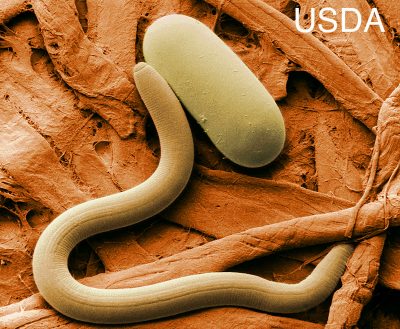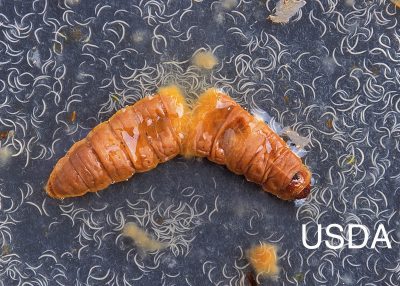“Worms” Good and Bad
Nematodes Galore
The name ”nematode” doesn’t conjure up a creature that you’d normally want to make friends with. It’s other name, roundworm, seems even more repulsive and is, in fact, also a name applied more specifically to a nematode that infects humans and dogs.
Like it or not, nematodes are all around us, with over 25,000 species described so far that inhabit diverse ecosystems from thousands of feet deep in the Earth to mountain tops, and from deserts to rain forests. Many are visible only under a microscope; some are two inches long. A square yard of soil can be home to more than a million nematodes, and we humans can be host to about 35 species.
Do we want our plants to cozy up with them?
A number of nematodes infect plants, resulting in stunted growth and, often, swellings on roots or stems.

Soybean cyst nematode
Their common names — root knot nematode, stubby root nematode, cyst nematode, lesion nematode — describe some of the symptoms. These plant pathogenic nematodes can do further ill by transmitting bacterial or viral diseases to plants.
I’m not particularly worried about nematodes in my garden. For one thing, they’re more prevalent in warmer climates. Also, good gardening practices, such as enriching the ground with compost, leafy mulches, and other organic materials, and crop rotation go a long way to thwarting such problems.
If I did have a nematode problem, or suspected one, I could reach into a quiver of “organic” solutions. Marigolds can suppress nematodes. Not just a plant here and there, though, but a solid planting of giant, African marigolds. Mustard has a similar effect, whether grown, like the marigolds, as a cover crop, or applied as a seed meal, which also happens to be a slow-release nitrogen fertilizer.
Chitosan, made from the shells of crustaceans and the active ingredient found in commercial products such as Serenade, reputedly bolsters plant defenses against nematodes and other pathogens. (My casual experimenting with Serenade against apple diseases found no benefit.)
Welcome “Worms”
In the same way that just about no one with an eye patch is a pirate, very few “nematodes” are bad guys. In the garden, so-called “predatory” nematodes are better than neutral; they are the “good guys,” preying on a wide range of garden pests.
Some of the most common beneficial nematodes are Steinernema carpocapsae, S. feltiae, and Heterorhabditisheliothidis bacteriophora. These three nematodes vary in their habits although they all attack a wide variety of garden pests. Steinernema carpocapsae is an “ambusher forager” that lies in wait near the soil surface for unwary pests to wander past. Heterorhabditisheliothidis bacteriophora is a “cruise forager” that moves around through various depths of soil, ready to pounce upon unsuspecting sedentary pests. The habitat and hunting behavior of S. feltiae nematodes is intermediate to the other two.

Waxworm releasing beneficial nematodes
Beneficial nematodes can be purchased. To be effective, they must be shipped at the right growth stage and applied without their drying out. Even then, annual applications are frequently needed.
Some strains of the beneficial nematodes can survive and multiply in the soil year after year. I imagine that my garden soil has plenty of “good” nematodes; perhaps more would be better. Some day I may extract some of the “good guy” nematodes from my soil, multiply them, and then re-apply them to my ground.
For now, I intend to get hold of a starter supply of native, perennial nematodes and multiply my holdings, a process which I think will have the added benefit of being fun and interesting. The three kinds of nematodes extracted from soils in central New York, are available for purchase from http://blogs.cornell.edu/ccefieldcropnews/2018/02/28/discount-available-on-biocontrol-nematodes-to-protect-alfalfa-corn-crops/.
With nematodes in hand, a nematode host is needed if I’m going to multiply them. Waxworms, sold for fishing bait, are a convenient host. The waxworms get incubated with the nematodes which, after a couple of weeks, are rinsed free of the waxworms with water.
The aqueous suspension of nematodes is then ready for application. To prevent their drying out, they’re best applied in early morning or evening along with plenty of water. If all goes as planned, they should establish and multiply to kill such pests as wireworms that bore into carrot and radish roots, plum curculio that attack apple, plum and peach fruits, and any cutworms that attack just about everything.
Come Visit My Farmden
Last minute notice: Come visit my farmden, in real life, on June 24th. As part of the Garden Conservancy Open Days program, I’ll be hosting visitors between 1 pm and 4:30 pm on that day. For more information about my farmden and other local sites, go to the https://www.gardenconservancy.org/open-days/open-days-schedule/ulster-county-ny-open-day-2.

